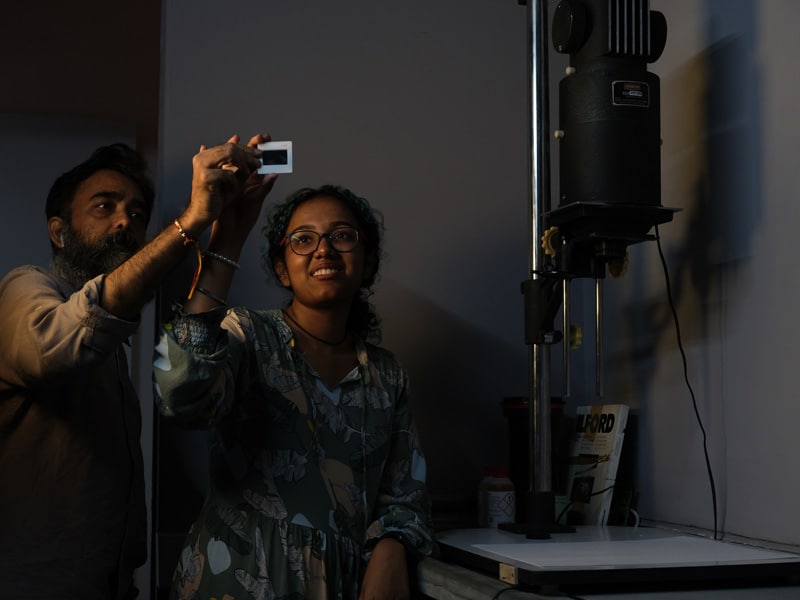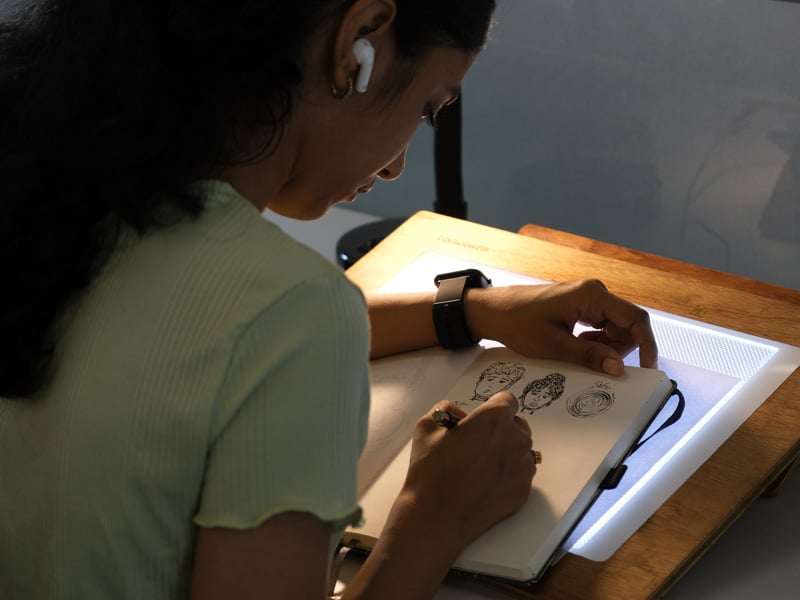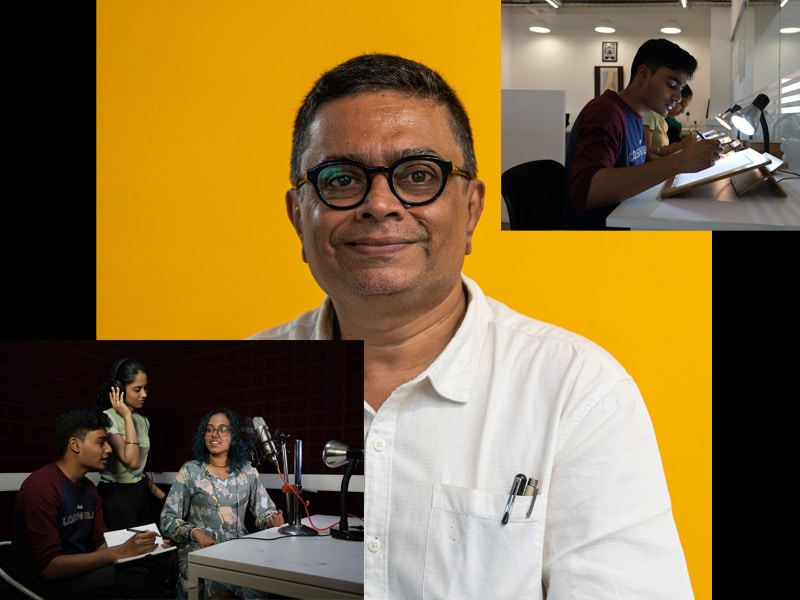Prof Sekhar Mukherjee, a filmmaker, cartoonist, and academician, is the Programme Lead at Anant, where he leverages his expertise in animation and comics to bridge societal gaps and enhance education. A National Institute of Design graduate, Sekhar encourages narrative diversity through the Longform Graphic Collective and aims to establish a center for sensory learning. At Anant, he develops cross-disciplinary projects and mentors students for intellectual and applied skill development, aspiring to create a global design story festival. Previously, as the Founding Director of NID, AP, he shaped the institute through extensive networking and collaborative projects, and developed the Chitrakatha festival into a renowned design story event. Sekhar’s contributions to design education earned him the CNBC TV18 Aptech Award, and he continues to support student entrepreneurship and international collaborations. A minimalist and humorist, Sekhar finds joy in cooking, sketching, and sharing stories, even extending his culinary skills to help others during the 2020 lockdown.
What is the significance of Anant National University being India’s first DesignX University?
Anant National University, India’s first DesignX university, is dedicated to nurturing young and young at heart into value-based, rooted and responsible professionals to devise alternative design solutions or create design opportunities while observing indigenous practices, applying creative thinking and fusing contemporary technologies.
Our DesignX way is unique in supporting young minds in developing a better understanding of the context we live in through community immersion, innovation and collaboration. The core of our pedagogy is sustainable design multiplied by a host of knowledge disciplines and technology to make problem-solving sustainable and impactful. Our multidisciplinary undergraduate, postgraduate and doctoral programmes in design, architecture, climate action and visual arts harness the knowledge from various disciplines and traditional practices to integrate it with relevant technology to address diverse challenges.
We train our designers to become solutionaries – revolutionary thinkers with a solution-oriented mindset.
How does Anant National University aim to bridge the gap between contemporary socio-economic challenges and sustainable solutions?
In today’s rapidly changing world, the combination of DesignX with disciplines such as Artificial Intelligence, Augmented and Virtual Reality, Analytics, Biomimicry, Sociology, Economics, Behavioural Science and Public Policy is imperative. Such a multidisciplinary approach to learning builds a comprehensive understanding of our world. It serves as an exponential force multiplier to ensure that our design community continues to deliver innovative, affordable and impactful solutions to the challenges of contemporary society and the environment.
At Anant, we shape young designers who possess technical skills and a holistic understanding of the context. They are good communicators, collaborative workers and critical thinkers. Our pedagogy encourages students to build a revolutionary mindset and cultivate a habit of seeking realistic solutions to local, national and global design issues by applying knowledge of various domains to their design projects.
What is the unique aspect of the DesignX way at Anant National University?
At Anant, design education is enhanced with the interplay of hand-heart-mind – Learning by Doing. Knowledge creation with experts from diverse disciplines makes Anant a one-of-a-kind university in India. The core philosophy of Anant’s education culture is value-based and rooted, supporting a dynamic multidisciplinary curriculum to create a design-enabled society.

How does the university integrate traditional practices with cutting-edge technology in its multidisciplinary programmes?
The undergraduate, postgraduate and doctoral programmes in Design, Architecture, Climate Action and Visual Arts harness the knowledge from various disciplines and traditional practices to integrate it with responsible technology to address diverse challenges. With the advent of available digital tools and affordable technology, students can unlearn with their mentors to practice fundamentals using analogue methods, preparing them to leap into the real world. Experienced and practice-based internal as well as visiting experts enrich this multidisciplinary and interdisciplinary programme further.
How would you define your role in shaping the curriculum at Anant National University?
Being a professional who dons many hats with a background in commerce, art, design, education, curation and smart administration, I wish to bring a more robust and dynamic curriculum to mentor new generation ‘solutionary’ storytellers from my current department of Moving Image as well as from other verticals to connect. As a compassionate mentor, my efforts will be directed at helping students become future-ready professionals. I also wish to enrich the curriculum by utilising my local, national and global network and make the course contents contextual and functional, innovative and original and affordable and sustainable. I love to break silos and bring various disciplines together to make the optimum use of university resources and add more value for the students.
How does Anant National University’s approach to design education differ from traditional design schools?
At Anant, we ensure our students immerse themselves in communities, understand problems from a futuristic and global outlook and solve problems through a multidisciplinary approach. Anant offers a broad range of minors, electives and workshops to students in more than one discipline to align with the new education policy.
Our pedagogy follows five design thinking principles that teach our students to understand, empathise, analyse and design for diverse contemporary scenarios.

Our faculty members have cosmopolitan exposure from reputed academic institutes from India and abroad. We have national and international collaborations with universities, industry partners and organisations of social impact like the University of Pennsylvania, the University of Miami, Cardiff University, Salzburg Global Seminar, India Accelerator, iHub – Gujarat to name a few. Students at Anant get to interact with reputed professionals and experts from various industries through masterclasses, faculty/student exchanges, workshops, electives and internships.
What are the core attributes that Anant National University aims to develop in its students through its design education programmes?
Anant aims to prepare responsible, value-based design professionals who are empowered with both analogue and digital skills. We ensure that our students become collaborative problem solvers with an understanding of the context, effective communication skills and the ability to think critically.
How does the Centre of Moving Image at Anant National University prepare students for careers in design and storytelling?
The Centre for Moving Image offers a major and minor along with a host of electives dedicated to shaping storytelling aspirants into responsible professionals equipped with the necessary survival skills and sensibilities. Our well-designed semesters give students sequential and quality inputs in Moving Image basics like film theory, media appreciation, content writing, word image exercise, locomotion, cinematography, sound design, image editing, emerging media, etc. The School of Design at Anant educates the students on how to fit into various industries as well as become job creators.
The Centre nurtures the students into proficient and pragmatic storytellers aided with various design inputs and media technologies. The Moving Image programme acts as a dynamic crucible for skill enhancement, fostering personal growth and industry readiness through a resolute focus on innovation, technique and relevant industry standards. Eventually, the department will evolve as a global centre of excellence, producing multilingual content for India and giving space for learners from all age groups from India and abroad by celebrating an iconic biennial International Student Storytelling Festival.

